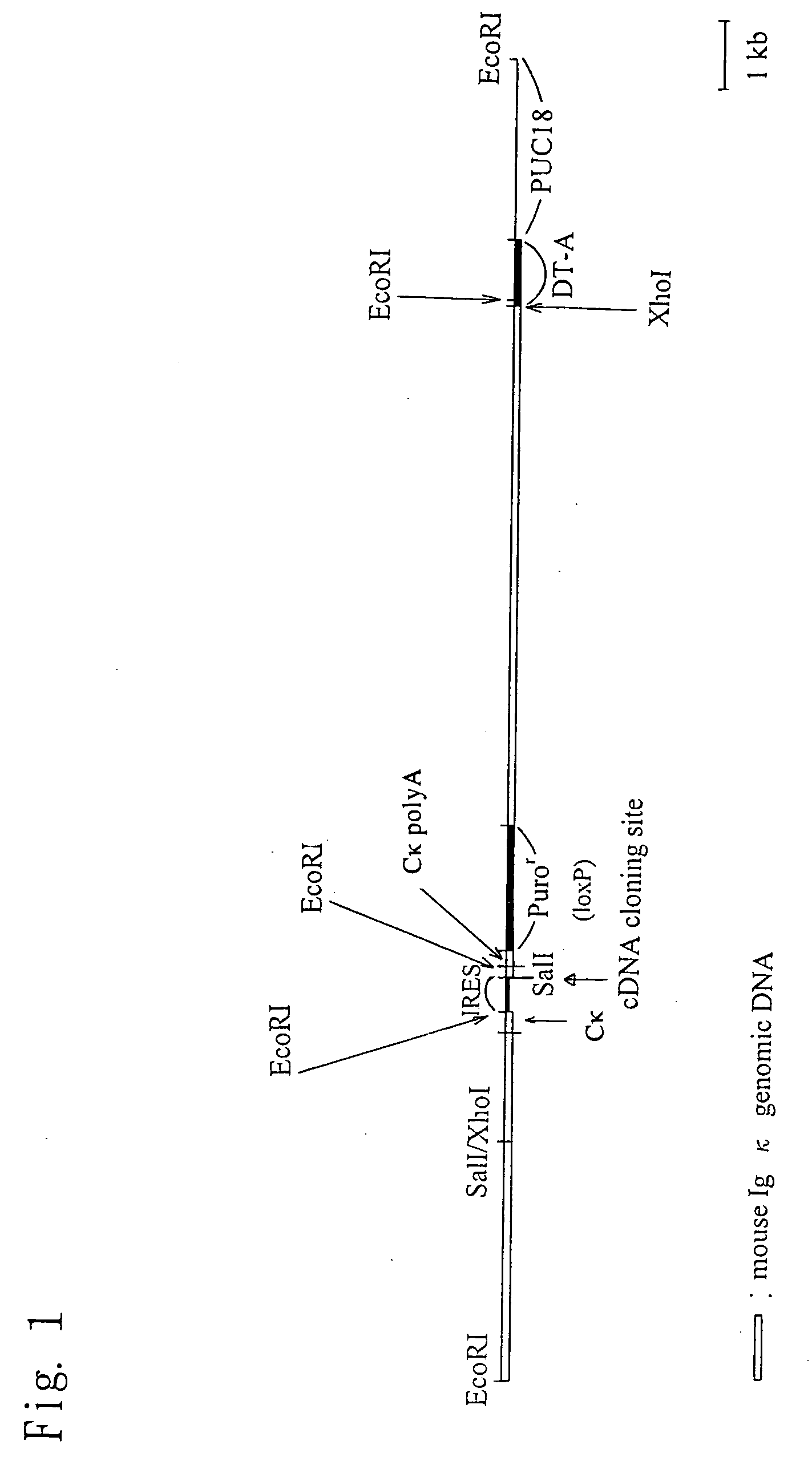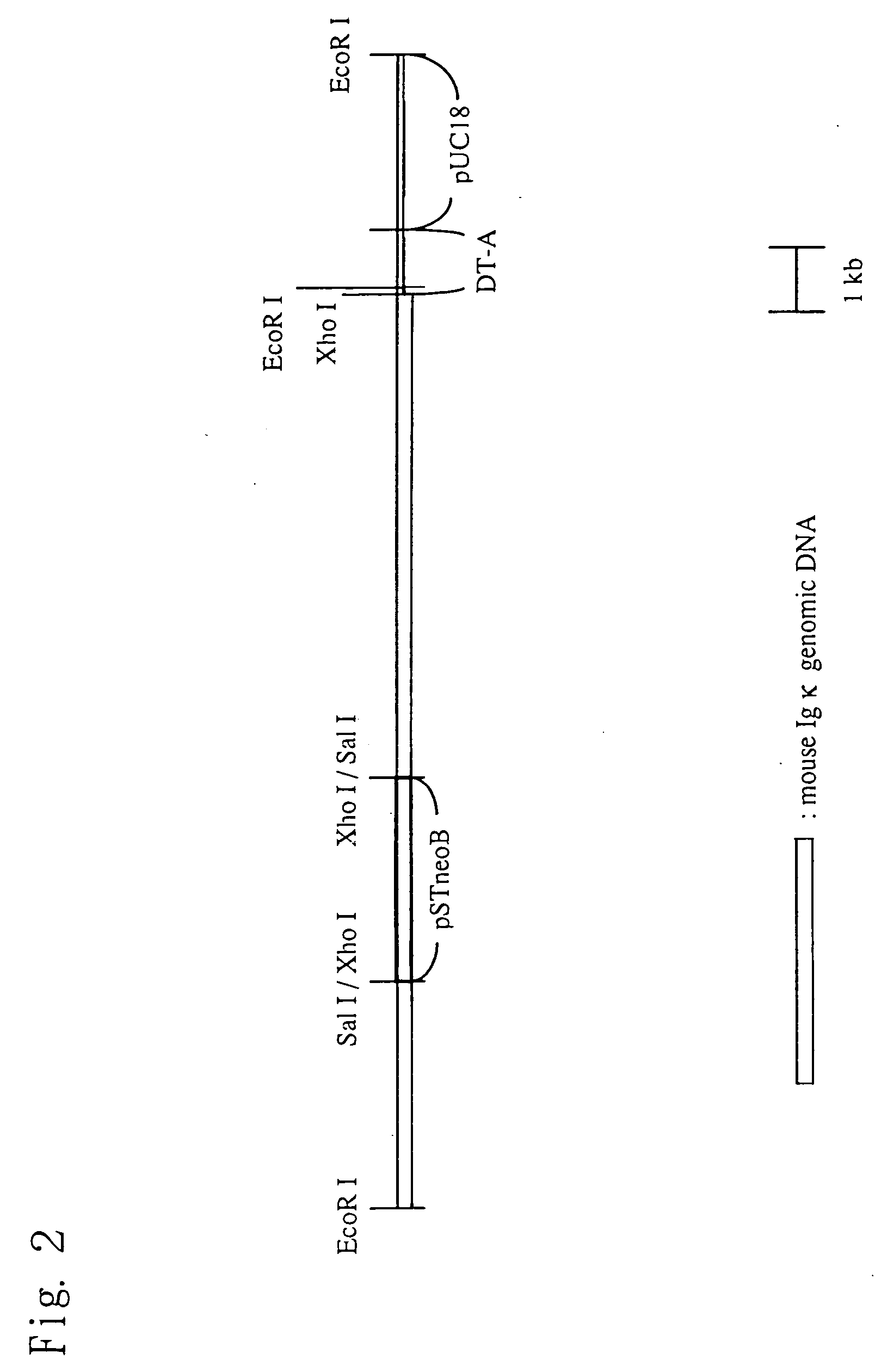Chimeric nonhuman animal
a non-human animal and chimeric technology, applied in the field of chimeric non-human animals, can solve the problems of inability to address the problem of tg mice and ko mice, and the development of efficient functional analyses of novel genes, and achieve the effects of promoting the action of various nucleic acid synthesis systems, improving the efficiency of dna introduction into mammalian cells, and providing stabilization and conformational changes in dna
- Summary
- Abstract
- Description
- Claims
- Application Information
AI Technical Summary
Benefits of technology
Problems solved by technology
Method used
Image
Examples
example 1
Construction of Knock-in Vector pKIκ
[0182] (1) Preparation of a Fragment in the Vicinity of a Cloning Site
[0183] A restriction enzyme recognition sequence (Sal I recognition sequence) for the insertion of an internal ribosomal entry site (IRES) and a nucleic acid sequence encoding a desired protein (to be introduced) is introduced between the termination codon portion and a polyadenylation signal (PolyA signal) of a mouse immunoglobulin kappa chain (Igκ) gene. Then a puromycin-resistance gene is inserted downstream of the PolyA signal, thereby preparing a genomic fragment. The method is specifically described below.
[0184] (1.1) Preparation of Upstream Fragment of a Cloning Site
[0185] The following DNAs were synthesized from the nucleotide sequence encoding a mouse IgGκ gene obtained from GenBank (NCBI, U.S.A.).
(SEQ ID NO: 1)igkc1:atctcgaggaaccactttcctgaggacacagtgatagg(SEQ ID NO: 2)igkc2:atgaattcctaacactcattcctgttgaagctcttgac
[0186] An Xho I recognition sequence was added to the ...
example 2
Insertion of TPO Gene into pKIκ
[0201] (1) Preparation of Mouse Thrombopoietin (TPO) Gene for Insertion into pKIκ
[0202] The following DNAs were synthesized from the nucleotide sequence encoding a mouse TPO gene (International Publication WO 95 / 18858 pamphlet).
(SEQ ID NO: 9)tpoN:CCGCTCGAGCGGCCACCATGGAGCTGACTGATTTGCT(SEQ ID NO: 10)tpoR:CCGCTCGAGCGGCTATGTTTCCTGAGACAAATTCC
[0203] An Xho I recognition sequence and a Kozak sequence were added to the 5′ side of the terminus of tpoN, which was the 5′ primer, and Xho I recognition sequence was added to the terminus of tpoR, which was the 3′ primer.
[0204] A reaction solution was prepared using TaKaRa LA-Taq (TAKARA BIO INC., Japan) according to the instructions by manufacturer. To 100 μL of the reaction solution, 10 pmol of each primer and 100 pg of Marathon-Ready cDNA (Mouse Liver, Clontech, U.S.A.) as a template were added. The solution was kept at 94° C. for 30 seconds, and then subjected to 25 cycles of amplification, each cycle consisti...
example 3
Preparation of TPO Knock-in ES Cell Line
[0209] To prepare a mouse ES cell line wherein TPO-cDNA was inserted downstream of an immunoglobulin κ light chain gene by homologous recombination, the TPO knock-in vector prepared in Example 2 was linearized with an Xho I restriction enzyme (TAKARA BIO INC., Japan), and then transfected into a TT2F mouse ES cell (Yagi et al., Analytical Biochem., 214: 70, 1993) by an established method (Shinichi Aizawa, Bio Manual Series 8, Gene Targeting, YODOSHA, 1995).
[0210] The method for culturing TT2F was performed as described (Shinichi Aizawa, supra). Feeder cells used herein were G418-resistant primary cultured cells (purchased from Invitrogen, Japan) treated with mitomycin C (SIGMA, U.S.A.). First, the propagated TT2F cells were trypsinized, and then suspended in HBS to achieve a concentration of 3×107 cells / ml. 0.5 ml of the cell suspension was admixed with 10 μg of the vector DNA, and then the mixture was subjected to electroporation using a Ge...
PUM
| Property | Measurement | Unit |
|---|---|---|
| Distance | aaaaa | aaaaa |
Abstract
Description
Claims
Application Information
 Login to View More
Login to View More - R&D
- Intellectual Property
- Life Sciences
- Materials
- Tech Scout
- Unparalleled Data Quality
- Higher Quality Content
- 60% Fewer Hallucinations
Browse by: Latest US Patents, China's latest patents, Technical Efficacy Thesaurus, Application Domain, Technology Topic, Popular Technical Reports.
© 2025 PatSnap. All rights reserved.Legal|Privacy policy|Modern Slavery Act Transparency Statement|Sitemap|About US| Contact US: help@patsnap.com



